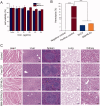Cepharanthine loaded nanoparticles coated with macrophage membranes for lung inflammation therapy
- PMID: 34866533
- PMCID: PMC8654408
- DOI: 10.1080/10717544.2021.2009936
Cepharanthine loaded nanoparticles coated with macrophage membranes for lung inflammation therapy
Abstract
Acute lung injury (ALI) is a disease associated with suffering and high lethality, but to date without any effective pharmacological management in the clinic. In the pathological mechanisms of ALI, a strong inflammatory response plays an important role. Herein, based on macrophage 'homing' into inflammation sites and cell membrane coating nanotechnology, we developed a biomimetic anti-inflammation nanosystem (MM-CEP/NLCs) for the treatment of ALI. MM-CEP/NLCs were made with nanostructured lipid carriers (NLCs) coated with natural macrophage membranes (MMs) to achieve effective accumulation of cepharanthine (CEP) in lung inflammation to achieve the effect of treating ALI. With the advantage of suitable physicochemical properties of NLCs and unique biological functions of the macrophage membrane, MM-CEP/NLCs were stabilized and enabled sustained drug release, providing improved biocompatibility and long-term circulation. In vivo, the macrophage membranes enabled NLCs to be targeted and accumulated in the inflammation sites. Further, MM-CEP/NLCs significantly attenuated the severity of ALI, including lung water content, histopathology, bronchioalveolar lavage cellularity, protein concentration, and inflammation cytokines. Our results provide a bionic strategy via the biological properties of macrophages, which may have greater value and application prospects in the treatment of inflammation.
Keywords: Macrophage membrane; acute lung injury; bionic nanocarrier; cepharanthine; inflammation.
Conflict of interest statement
No potential conflict of interest was reported by the author(s).
Figures






References
-
- Bender EA, Adorne MD, Colome LM, et al. (2012). Hemocompatibility of poly(ɛ-caprolactone) lipid-core nanocapsules stabilized with polysorbate 80-lecithin and uncoated or coated with chitosan. Int J Pharm 426:271–9. - PubMed
-
- Bullard DC, Mobley JM, Justen IM, et al. (1999). Acceleration and increased severity of collagen-induced arthritis in P-selectin mutant mice. J Immunol 163:2844–9. - PubMed
-
- Cao H, Dan Z, He X, et al. (2016). Liposomes coated with isolated macrophage membrane can target lung metastasis of breast cancer. ACS Nano 10:7738–48. - PubMed
MeSH terms
Substances
Supplementary concepts
LinkOut - more resources
Full Text Sources
Other Literature Sources
Medical
